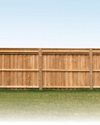
While a lot can be said for well-draining gravel, the material of choice has long been concrete mix. It's available in 50-lb. bags at any home center, and you usually need two bags per post. For a 100-ft. fence with 10 posts, that means lugging half a ton or more of concrete mix to the site, mixing it with water and shoveling it into the holes.
If a lightweight alternative to concrete performed just as well, many fence builders would choose it just to save their backs. Fence post setting foam offers promise, but is it just as good as concrete?
We asked two experts who set posts with foam: Alex Capozzolo, cofounder of Brotherly Love Real Estate in Philadelphia, and Forrest McCall, co-owner of the home improvement blog "Mama Needs a Project."
The use of expanding foam to set fence posts is a recent innovation. We asked two experts how foam compares with concrete for strength and usability.
EXPANDING FOAM VS. CONCRETE
Post-setting foam is a two-part product, and before use, the parts must be mixed, which is done right in the bag. It's far lighter than concrete mix. Each bag contains enough material for a single post and weighs only 2 or 3 lbs.
Note: Unlike spray foam in an aerosol can, post-setting foam is a closed-cell formulation without air bubbles, making it more rigid. Most insulating foam is open cell.
BRACING IS KEY
Whether you backfill with concrete or foam, you dig the same size postholes to the same depth, which should be one-third the length of the entire post for stability.
Backfilling is more difficult with foam. Because the foam expands when it sets, McCall says the post tends to move if not braced properly. Capozzolo adds that there's little time to fix leveling errors. Bracing is also recommended with concrete, but it isn't as critical because concrete sets more slowly and provides plenty of time for readjustment.
This story is from the {{IssueName}} edition of {{MagazineName}}.
Start your 7-day Magzter GOLD free trial to access thousands of curated premium stories, and 9,000+ magazines and newspapers.
Already a subscriber ? Sign In
This story is from the {{IssueName}} edition of {{MagazineName}}.
Start your 7-day Magzter GOLD free trial to access thousands of curated premium stories, and 9,000+ magazines and newspapers.
Already a subscriber? Sign In

7 Bicycle Maintenance Tips
Keep your bike in tiptop shape and ride safe!

SETTING FENCE POSTS WITH EXPANDING FOAM
Any fence builder knows you need strong posts for a strong fence, and that means backfilling the postholes with a dense, hard material other than dirt.

PEBBLE MOSAIC STEPPING STONES
COLLECT SOME RIVER ROCK AND MAKE YOUR OWN UNIQUE STEPPINGSTONE PATH

EARTH-FRIENDLY WEED KILLERS
HEALTHIER CHOICES FOR HUMANS AND THE ENVIRONMENT

DIY! HYDROPONIC GARDEN
FRESH VEGETABLES AT YOUR FINGERTIPS

GROW MINI VEGETABLES
GROW A GARDEN IN A TINY SPACE!

BUILD A VERTICAL GARDEN
TIME TO GROW UP!

MODERN WATER FOUNTAINS
A SPLASH OF PEACE FOR YOUR PATIO

9 ALTERNATIVE USES FOR SAWDUST
Every fully stocked wood shop has a table saw. You can usually find a pile of sawdust under it, even if it's used only occasionally. If a shop has a belt sander or band saw, there's probably another pile of finer sawdust under that. Even people without stationary tools have sawdust accumulation on their workbenches.

INSULATE WITH FOAM
IT'S A GREAT ALTERNATIVE TO FIBERGLASS